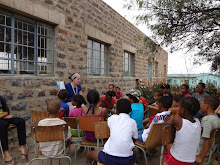 Last Friday, I got to see the Pyramids and the Sphinx up close, and it was everything I've been dreaming it would be since the sixth grade, when Mrs. Hufford's social studies class gave me my first taste of the worlds thousands of years and miles away from Naperville.
Last Friday, I got to see the Pyramids and the Sphinx up close, and it was everything I've been dreaming it would be since the sixth grade, when Mrs. Hufford's social studies class gave me my first taste of the worlds thousands of years and miles away from Naperville.In a sense, this trip has been nearly a decade in the making. I think that my fascination with foreign cultures and civilizations can be best dated to that sixth grade class - all I remember about my elementary school social studies education is learning about the pioneers ad nauseum in third? fourth grade? - and while the rest of junior high social studies didn't exactly light a fire under me, my high school curriculum took me from the dawn of civilization to the Cold War. And so here I find myself, in Cairo and inching closer to graduating from Madison, and even though it hasn't been as easy or as straightforward as I'd have liked, I'm here nonetheless.
Our Giza tour was conducted by Dr. Karim, the same professor who gave the Cairo tour the previous weekend, and the woman is a veritable fountain of information about all things Egyptian, past and present. After we all ran off the bus and took our photos with the Pyramid of Cheops (you can see one of mine above), the group congregated at the northeast corner of the pyramid for a few brief tidbits of information before we set off for the smaller monuments in the complex.

The Pyramids of Giza are part of a greater set of ancient monuments known collectively as the Giza Necropolis, which includes the smaller pyramids and tombs near the Giza pyramids, the Sphinx, and the Cheops Boat Museum. During our trip, we were able to view the insides of tombs and pyramids, as well as tour the Boat Museum (you can see photos of that at my Flickr site; the link is in the left navigation bar).
Our first stop after Cheops' Pyramid was a nearby mastaba, the low underground tombs of the nobles. (The word "mastaba" comes from the Arabic for "bench" because that's what these tombs looked like to the Arab invaders.) Assisting with the tour was an Egyptology graduate student, Ahmed, who told us that the inscriptions on the inside of the mastaba, which were so well preserved you could count individual feathers on the birds, said that this particular tomb belonged to an important record-keeper. The inside of the queen's pyramid we viewed (that of Queen Hetepheres, mother of Cheops) was not terribly exciting, since, as Ahmed told us, traditional pyramids do not contain any type of decoration on the inside. (One archaeologist's famous last words were allegedly "Pyramids do not have carvings!" though I will have to reinquire whose.) However, climbing sideways-up out of the pyramid was the best leg workout I've had in quite a while.
Our next stop was the Cheops Boat Museum, which as its name might lead you to think, contains a boat belonging to Cheops - a funerary boat, to be precise. Each pharaoh buried at Giza had a full-sized boat among his possessions for the afterlife, the purpose of which was to carry his soul across the sky with the setting sun. Cheops'
 boat was found in thousands of pieces and reconstructed; it is believed that it may actually have been used during his lifetime, due to evidence of submersion in some of the pieces. The museum is built around the limestone pit where the boat was uncovered, and contains several displays on the reconstruction process, which were fairly interesting.
boat was found in thousands of pieces and reconstructed; it is believed that it may actually have been used during his lifetime, due to evidence of submersion in some of the pieces. The museum is built around the limestone pit where the boat was uncovered, and contains several displays on the reconstruction process, which were fairly interesting.We walked up towards the Pyramid of Khafre, marveling at the remnants of its limestone cap, towards the bus for a quick water break. The bus took us to a plateau on the outskirts of the complex where we could photograph all three pyramids together, and then back into Giza for our final stop. We got to tour Khafre's Valley Temple, the only remaining pharaonic temple at Giza - originally, each pharaoh had two temples (a Funerary Temple and Valley Temple) - which was quite beautiful, and then the Sphinx. Dr. Karim told us that the Sphinx's nose was destroyed by the Mamaluk armies, who used it for target practice; I had heard that it was Napoleon's soldiers who were to blame, and Stephanie told me that she'd heard it was because tourists were trying to climb the face of the monument? I think that last one has got to be false - there is no way anyone would want to climb the face of that thing, but maybe I'm wrong. This is what I do know: the Sphinx is believed to be in the likeness of Khafre, and to have been constructed during his reign from a single block of limestone. And kissing the Sphinx is one of the most popular photos to take. Please see my Flickr site or current Facebook profile for my take on this.

2 comments:
No broken limbs?
Haha, no. But I have told that story all over campus.
Post a Comment